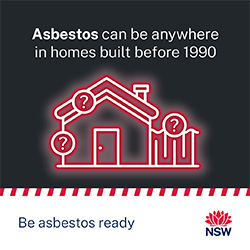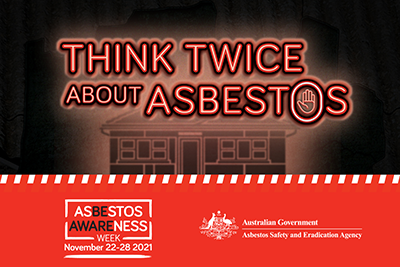National Asbestos Awareness Week
This National Asbestos Awareness Week we’re reminding you that homes built before 1990 are likely to contain asbestos.
Danger from asbestos is far from over.
Australia has one of the highest rates of asbestos related-disease in the world and it is still present in one in three Australian homes, as well as in public and commercial buildings.
Think ahead
If the home or building you are working on was built before 1990, then it is likely to contain asbestos. It was used in over 3,000 building products.
If you’re not sure whether asbestos might be present at a site, don’t do anything until you’ve had it checked by a licensed asbestos professional. You can check a licence is valid on Verify.licence.
If you’re working on a commercial building that was built before December 2003, ask to see a copy of the asbestos register before doing any work.
Never use high pressure water, a garden hose with a trigger attachment or compressed air on asbestos roofing or other products containing asbestos, such as fences, eaves, gutters and downpipes.
Friable asbestos can be found inside the ceiling cavity in the form of loose-fill asbestos insulation.
Plan
Asbestos is dangerous when disturbed, so you shouldn’t remove asbestos yourself. Use the Planning Checklist to assess and plan the work.
Get a licensed asbestos professional
SafeWork NSW always recommends using a licensed asbestos removalist to remove any amount of asbestos.
You must use a licensed asbestos removalist to remove any amount of friable asbestos or to remove more than 10 sqm of non-friable asbestos.
If you are going to remove or work with less than 10 sqm of non-friable asbestos yourself, then you should always do so in line with the SafeWork NSW Code of Practice: How to safely remove asbestos (PDF, 2770.66 KB).
You should also watch our series of asbestos videos which demonstrate all the steps you need to keep you safe when working with asbestos.
Online Asbestos awareness and safety course
Employers have a legal obligation to provide workers such as tradespeople and other workers, who are likely to encounter asbestos on the job, with asbestos awareness training.
SafeWork NSW has an online Asbestos Awareness & Safety course, which once completed, helps meet those legal obligations and aims to give participants the skills to protect themselves and their colleagues from harmful asbestos fibres and dust.
With over 20,000 enrolments in the course and a feedback rating of 4.3 out of 5 stars, if you or your workers haven’t completed asbestos awareness training, but you are likely to encounter asbestos on the job then you should join the thousands of others who have done this training and enrol now.
This self-paced, online course will teach you how to:
- recognise the risks and serious long-term impacts of asbestos exposure
- determine if asbestos-containing material may be present on site
- avoid hazardous work practices can that lead to asbestos exposure
- safely handle asbestos and asbestos-containing materials
- inspect worksites and communicate asbestos risks and asbestos controls with an informed perspective.
Further training is required to do licensed asbestos removal work, such as removing more than 10sqm of non-friable asbestos or any amount of friable asbestos.
Resources for culturally and linguistically diverse (CALD) workers
Guidance material including fact sheets, flyers and posters are available translated into Arabic, Assyrian, Cantonese, Dari, Khmer, Korean, Mandarin, Punjabi and Vietnamese.
View translated guidance material
Our video explaining the dangers of pressure cleaning asbestos roofs is available in Arabic, Cantonese, Mandarin, and Vietnamese.
Related information
For more information about asbestos safety, visit the SafeWork NSW asbestos page.
Read more about working as a licensed asbestos removalist.
For more information about how to apply for an asbestos licence, visit the SafeWork NSW licence page.

2023
Danger from asbestos is far from over.
Australia has one of the highest rates of asbestos related-disease in the world and it is still present in one in three Australian homes, as well as in public and commercial buildings.
Be abestos ready
Asbestos is in 1 in 3 Australian homes
To stay safe at work, follow these simple steps:
Think ahead
If the home or building you are working on was built before 1990, then it is likely to contain asbestos. It was used in over 3,000 building products.
If you’re not sure whether asbestos might be present at a site, don’t do anything until you’ve had it checked by a licensed asbestos professional. You can check a licence is valid on Verify.licence.
If you’re working on a commercial building that was built before December 2003, ask to see a copy of the asbestos register before doing any work.
Never use high pressure water, a garden hose with a trigger attachment or compressed air on asbestos roofing or other products containing asbestos, such as fences, eaves, gutters and downpipes.
Friable asbestos can be found inside the ceiling cavity in the form of loose-fill asbestos insulation.
Plan ahead
Asbestos is dangerous when disturbed, so you shouldn’t remove asbestos yourself. Use the Planning Checklist to plan ahead.
Get a licensed asbestos professional
SafeWork NSW always recommends using a licensed asbestos removalist to remove any amount of asbestos.
You must use a licensed asbestos removalist to remove any amount of friable asbestos or to remove more than 10 sqm of non-friable asbestos.
If you are going to remove or work with less than 10 sqm of non-friable asbestos yourself, then you should always do so in line with the SafeWork NSW Code of Practice: How to safely remove asbestos (PDF, 2770.66 KB).
You should also watch our series of asbestos videos which demonstrate all the steps you need to keep you safe when working with asbestos.

Asbestos awareness and safety course
A new online and interactive asbestos awareness and safety course has launched. You will learn about identification, safe handling and controls of asbestos in the workplace and more. The course is is aimed at NSW tradespeople, demolition workers, renovators and handypersons.
Completion of this course does not allow you to remove more than 10sqm of non-friable asbestos or any amount of friable asbestos. In order to conduct this work, further training and experience in asbestos removal is required.
Resources for culturally and linguistically diverse (CALD) workers
Guidance material including fact sheets, flyers and posters are available translated into Arabic, Assyrian, Cantonese, Dari, Khmer, Korean, Mandarin, Punjabi and Vietnamese.
View translated guidance material
Our video explaining the dangers of pressure cleaning asbestos roofs is available in Arabic, Cantonese, Mandarin, and Vietnamese.
Related information
For more information about asbestos safety, visit the SafeWork NSW asbestos page.
Read more about working as a licensed asbestos removalist.
For more information about how to apply for an asbestos licence, visit the SafeWork NSW licence page.
2022
Danger from asbestos is far from over.
Australia has one of the highest rates of asbestos related-disease in the world and it is still present in one in three Australian homes, as well as in public and commercial buildings.
New on-the-spot asbestos fines
From 14 October 2022, SafeWork NSW inspectors can issue on-the-spot fines to workers who don’t follow asbestos-safe work procedures.
Changes to the Work Health and Safety Regulation 2017 allow SafeWork NSW to issue on-the-spot fines for asbestos-related offences. Offences may include (this is not an all-inclusive list):
- using high-pressure water or compressed air on asbestos roofs
- breaking asbestos-containing materials (ACM)
- using power tools or other prohibited equipment on ACM
- dry-sweeping ACM
- not engaging an asbestos professional to conduct clearance inspections
- not having adequate signage and barricades at asbestos removal sites
- issuing clearance certificates without attending the site
- issuing clearance certificates when ACM has not been adequately removed.
Be abestos ready
Asbestos is in 1 in 3 Australian homes
To stay safe at work, follow these simple steps:
Think ahead
If the home or building you are working on was built before 1990, then it is likely to contain asbestos. It was used in over 3,000 building products.
If you’re not sure whether asbestos might be present at a site, don’t do anything until you’ve had it checked by a licensed asbestos professional. You can check a licence is valid on Verify.licence.
If you’re working on a commercial building that was built before December 2003, ask to see a copy of the asbestos register before doing any work.
Never use high pressure water, a garden hose with a trigger attachment or compressed air on asbestos roofing or other products containing asbestos, such as fences, eaves, gutters and downpipes.
Friable asbestos can be found inside the ceiling cavity in the form of loose-fill asbestos insulation.
Plan ahead
Asbestos is dangerous when disturbed, so you shouldn’t remove asbestos yourself.
Get a licensed asbestos professional
SafeWork NSW always recommends using a licensed asbestos removalist to remove any amount of asbestos.
You must use a licensed asbestos removalist to remove any amount of friable asbestos or to remove more than 10 sqm of non-friable asbestos.
If you are going to remove or work with less than 10 sqm of non-friable asbestos yourself, then you should always do so in line with the SafeWork NSW Code of Practice: How to safely remove asbestos (PDF, 2770.66 KB).
You should also watch our series of asbestos videos which demonstrate all the steps you need to keep you safe when working with asbestos.

2021

In 2021, asbestos is still a present danger when you’re working on older houses.
In fact, asbestos shows up in 1 in 3 homes across Australia.
This National Asbestos Awareness Week, we’re reminding you to Think Twice About Asbestos.
Because it’s still in millions of homes and still causing cancer in Australians.
Being aware of asbestos safety is an ongoing responsibility.
To stay safe at a job, follow these simple steps:
1. Check up
If the home was built or renovated before 1990, know what you need to do to be safe. If you’re not sure whether asbestos might be present then call a licensed asbestos professional to check before doing anything.
Watch our Asbestos Hazards, Risks and Identification video for more information on how to identify whether asbestos might be present.
2. Gear up
Asbestos is in a third of all homes. Before starting work, protect yourself with the right personal protective equipment (PPE) including the right mask.
Watch our video to see what PPE you need when working with asbestos and how to put it on correctly to keep you safe.
3. Remove safely
SafeWork NSW always recommends using a licensed asbestos removalist to remove any amount of asbestos. You must use a licensed asbestos professional to remove any amount of friable asbestos or to remove more than 10sqm of non-friable asbestos.
If you are going to remove or work with less than 10sqm of non-friable asbestos yourself then you should always do it in line with the Code of Practice – How to safely remove asbestos [PDF]. For more information on how to remove or work with less than 10sqm of asbestos safely, watch our videos on:
Set up your work area
This video demonstrates how to set up an asbestos work area if you need to work with or remove less than 10sqm of non-friable asbestos.
Manage asbestos safely on the job
This video demonstrates how to safely drill into asbestos containing materials.
Decontaminate a job area
This is the final of five videos in a series, showing tradies how to manage asbestos safely on the job. This video demonstrates how to correctly decontaminate an asbestos work area when working with or removing less than 10sqm of non-friable asbestos.